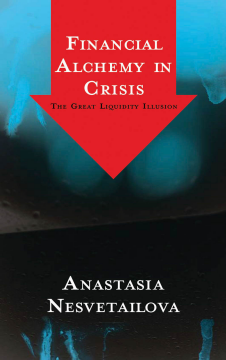
Additional Information
Book Details
Abstract
In July 2007, the combination of a seemingly unstoppable rise in house prices and bullish banks swimming in liquidity meant that almost anyone could get a mortgage in the UK or US. Little more than a month later the supply of credit dried up practically overnight, leaving the world wondering how bank liquidity could suddenly vanish.
In Financial Alchemy, Anastasia Nesvetailova shows that this liquidity never actually existed. The rise of sophisticated financial instruments created what appeared to be an abundance of liquid funds but was in fact a credit pyramid. As soon as house prices stopped rising the reality was exposed.
Nesvetailova's bold and radical analysis explains why the credit crisis was an inevitable consequence of entrusting the world economy to financiers who believe that they can 'create' money and wealth.
'There has always been a tendency to confuse money and wealth. Anastasia Nesvetailova shows that, from the beginning of securitisation until the crisis, this confusion transferred to the creation of the bewildering array of new financial instruments'
Victoria Chick, University College London
'Anastasia Nesvetailova is one of a small handful of economists who understands what has gone wrong in the financial markets. Without condescension or incomprehensible and uncomprehending jargon, she reveals the structural flaws in the financial system that was supposed to be the highest achievement of our business civilisation'
Jan Toporowski. Reader in Economics and Chair of the Economics Department, The School of Oriental and African Studies, University of London, and Research Associate in the Research Centre for the History and Methodology of Economics, University of Amsterdam.
'An excellent attempt to reinsert social and psychological notions into our views of 'the market' and its functions'
Paul J Davies, Financial Times
'In a crisply-written book that reads like a detective novel, Anastasia Nesvetailova shows how fraud, gaps in regulation, unchecked risk-taking, the sheer complexity of contemporary markets, and hubris by financial 'masters of the universe' have all played their part in the ongoing financial and economic crisis'
Gary Dymski
Table of Contents
| Section Title | Page | Action | Price |
|---|---|---|---|
| Cover | Cover | ||
| Contents | vii | ||
| Abbreviations | ix | ||
| Acknowledgements | x | ||
| Introduction: The End of a Great Illusion | 1 | ||
| ‘Liquidity’ and the Crisis of Invented Money | 4 | ||
| Liquidity Illusion and the Global Credit Crunch | 17 | ||
| 1. The Stages of the Meltdown | 24 | ||
| The Prelude: The American Sub-Prime Crisis | 24 | ||
| From Sub-Prime Crisis to the Global Credit Crunch | 28 | ||
| From Global Credit Crunch to Global Recession | 33 | ||
| 2. The Tale of Northern Rock:Between Financial Innovationand Fraud | 40 | ||
| The Controversy Over Financial Innovation | 43 | ||
| Offshore: The Uses and Abuses of SPVs | 48 | ||
| Northern Rock and Granite | 51 | ||
| 3. How the Crisis HasBeen Understood | 62 | ||
| Ex-Ante and Ex-Post Visions of the Credit Crunch | 62 | ||
| Structural Theories of the Credit Crunch | 71 | ||
| Cyclical Theories of the Crisis | 80 | ||
| 4. Some Uncomfortable Puzzlesof the Credit Crunch | 90 | ||
| Dismissed: The Warning Signs and the Whistleblowers | 91 | ||
| Ponzi Capitalism: A Crisis of Fraud? | 100 | ||
| 5. 2002–7: The Three Pillarsof the Liquidity Illusion | 113 | ||
| Liquidity and the Paradigm of Self-Regulating Credit | 113 | ||
| Playing with Debt – Together. Liquidity as a‘State of Mind’ | 121 | ||
| The Alchemists: Turning Bad Debts into ‘Money’ | 131 | ||
| 6. After the Meltdown: Rewritingthe Rules of Global Finance? | 143 | ||
| The Three Stages of the Policy Response | 144 | ||
| The Crisis and Geopolitics: A New Special Relationship? | 149 | ||
| Conceptual Dilemmas and Traps | 156 | ||
| Conclusion: A Very Mundane Crisis | 172 | ||
| Notes | 177 | ||
| Bibliography | 184 | ||
| Index | 197 |
